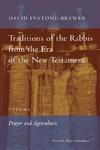
Book Summary
Foreword by Birger Gerhardsson "Traditions of the Rabbis from the Era of the New Testament (TRENT)" is a major new six-volume work of scholarship that provides an exhaustive collection of early rabbinic traditions and commentary on their relevance to the New Testament. Focusing on 63 rabbinic traditions central to ancient Jewish life, David Instone-Brewerbs massive study provides significant insights into Jewish thought and practice prior to the destruction of the Second Temple in 70 C.E. For each rabbinic tradition considered, the supporting Hebrew source text is provided side by side with an English translation. Instone-Brewer also presents evidence that exists for accurately dating these rabbinic sources -- a critical task recently advanced by modern dating techniques. He goes on to thoroughly discuss the meaning and importance of each rabbinic tradition for Second Temple Judaism, also analyzing any echoes or direct appearances of the tradition in the New Testament writings. In this first "TRENT" volume, Instone-Brewer examines texts relating to prayer and agriculture. The first section includes texts dealing with when and how to recite the Shema, the Eighteen Benedictions, and other blessings and prayers. The second section contains texts on a wide variety of considerations related to agriculture, such as the bleftoversb to which the poor were entitled, tithing, bmixedb foods and other products, Sabbath Year activities, offerings, and so on. Sure to be a standard reference work for students of both Judaism and Christianity, "TRENT" provides for the first time a ready resource on rabbinic traditions originating in the New Testament era. Features of "TRENT": Discusses 63topics that illuminate ancient Jewish life Follows the traditional order of subject divisions in the Mishnah Presents Hebrew/Aramaic texts in parallel with a literal English translation and notes on variants Provides dating evidence along with degree of certainty Offers commentary on the meaning and significance of rabbinic traditions in Second Temple Judaism Highlights the presence of rabbinic traditions in the New Testament writings Includes a full glossary of rabbinic terminology "Traditions of the Rabbis from the Era of the New Testament will be an invaluable resource for anyone interested in early Jewish tradition before 70 CE and in New Testament studies. In this six-volume work, Instone-Brewer collects and translates early rabbinic traditions that originated before the destruction of the Temple. The English translations and Hebrew texts are presented side by side, and technical terms are explained in the text and in a glossary. The author sets out the evidence for and against the early dating and development of each tradition and provides commentary accessible to nonrabbinic scholars. When evidence of the tradition is found in the New Testament, the appropriate text is explained and analyzed. Thus, for the first time, nonspecialists have ready access to early rabbinic traditions that originate from the New Testament era. In this first volume, the author examines texts relating to prayer and agriculture. The first section includes texts dealing with when and how to recite the Shema, the Eighteen Benedictions, and other blessings and prayers. The second section contains texts on a wide variety of considerations related to agriculture, such as the bleftoversb to which the poor are entitled, tithing, bmixedb foods and other products, Sabbath Year activities, offerings, and many others.
Book Details
| Book Name | Prayer And Agriculture |
| Author | David Instone-brewer |
| Publisher | William B. Eerdmans Publishing Company (Nov 2004) |
| ISBN | 9780802847621 |
| Pages | 456 |
| Language | English |
| Price | 2731 |








